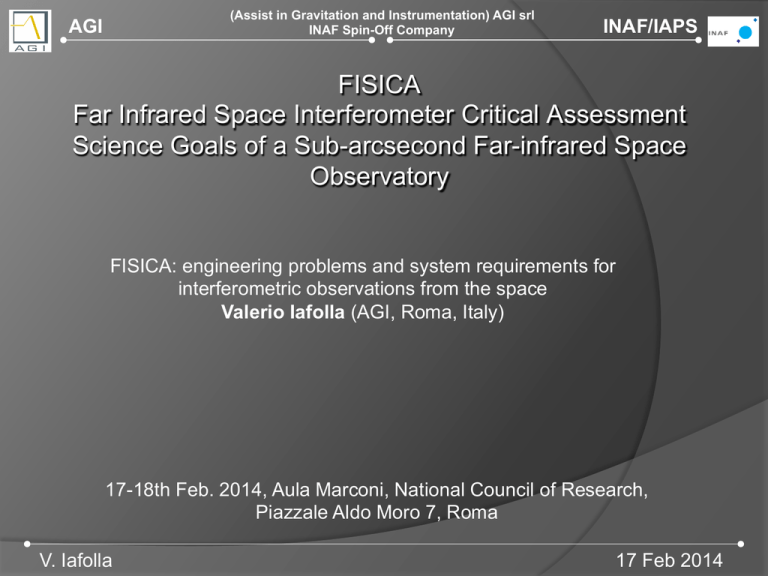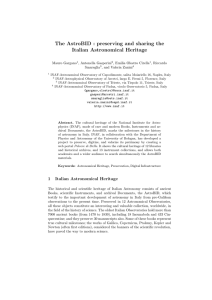FISICA Far Infrared Space Interferometer Critical Assessment
advertisement

(Assist in Gravitation and Instrumentation) AGI srl INAF Spin-Off Company AGI INAF/IAPS FISICA Far Infrared Space Interferometer Critical Assessment Science Goals of a Sub-arcsecond Far-infrared Space Observatory FISICA: engineering problems and system requirements for interferometric observations from the space Valerio Iafolla (AGI, Roma, Italy) 17-18th Feb. 2014, Aula Marconi, National Council of Research, Piazzale Aldo Moro 7, Roma V. Iafolla 17 Feb 2014 AGI (Assist in Gravitation and Instrumentation) AGI srl INAF Spin-Off Company INAF/IAPS In this talk will be analyzed some technological problems related to the interferometer development, with particular emphasis in the possible use of accelerometers on board of the satellites that seems to offer the following opportunity: ! to implement a control loop algorithms to keep the satellites in the appropriate positions during the observation time required to cover all the u,v plane, for each single source ! to permit to measure the level of vibrational noise presents on them. The heritage for these activities comes from the developments of the ISA (Italian Spring Accelerometer) an accelerometer conceived for the BepiColombo an ESA Cornerstone mission for the exploration of Mercury and to test the General Relativity. (Assist in Gravitation and Instrumentation) AGI srl INAF Spin-Off Company AGI INAF/IAPS m/s 2 Acceleration in the Euler Reference Frame 1000 2.38176e-10 800 600 1.9848e-10 400 1.58784e-10 meters 200 0 1.19088e-10 -200 -400 7.9392e-11 -600 3.9696e-11 -800 -1000 " +2$ ↓0 ×" +$ ↓0 ×" +$ ↓0 ×($ ↓0 × " )=(∙" -1000 -500 0 meters 500 1000 Accelerations in the Euler reference frame in L2, due to the gravity gradient. Orbital Trajectory for tw o satellites in Euler-Hill reference frame data1 data2 800 2000 600 1800 400 1600 0 meters meters 200 -200 -400 1400 -600 1200 -800 -1000 -500 0 meters 500 1000 Two satellites out of phase by 180 ° in a Euler non-inertial reference frame. 1000 0 0.5 1 1.5 2 Seconds 2.5 3 3.5 7 x 10 Relative distance between the two satellites AGI (Assist in Gravitation and Instrumentation) AGI srl INAF Spin-Off Company INAF/IAPS ) =(*∙ + ), −$ ×($ ×, )−$ ×, −2$ ((x(- − .↓/(0 −∆1 /∆3 |↓5)6 1. 2. 3. 4. Accelerations due to gravity gradients Apparent accelerations Non–gravitational accelerations (NGA), Accelerations due to thruster maneuvers Free-flyer Tethered Rigid Structure AGI (Assist in Gravitation and Instrumentation) AGI srl INAF Spin-Off Company INAF/IAPS AGI (Assist in Gravitation and Instrumentation) AGI srl INAF Spin-Off Company INAF/IAPS (Assist in Gravitation and Instrumentation) AGI srl INAF Spin-Off Company AGI INAF/IAPS Due to the conservation of the angular momentum, a change in the radial distance of interferometer telescopes results in a change of their associate angular and tangential velocity 20 10 0.8 30 0.2 2 4 6 8 time 10 4 x 10 Accelerations 0.04 linear 0 0 square cubic root 15 exponential 0.03 0.02 4 6 time 8 10 4 x 10 steps 0 0 2 4 6 time 8 10 -20 20 -30 10 -40 -50 -50 -10 50 -20 40 -30 30 -40 20 -50 -50 0 exponential 50 0 m 50 m 10 0 m 50 0 -10 50 10 cubic -20 -30 40 -40 30 5 0 -50 -50 20 m 0.01 2 30 0 m 20 0.4 40 -10 linear squarecubic root exponential 4 x 10 The five trajectories. In red linear law, in green the square, in blue the cubic, in yellow the square-root and in cyan the exponential one. 10 50 0 40 -10 30 root 20 -20 10 -30 m [m/s] 0.6 meters [m/s 2] meters 40 0 m square 50 0 30 Velocities 50 10 40 m Radius linear 50 -40 0 -10 -50 -50 0 m 50 -20 -30 -40 -50 -50 0 m 50 (Assist in Gravitation and Instrumentation) AGI srl INAF Spin-Off Company AGI INAF/IAPS In order to have a constant tangential velocity along a spiral trajectory, the system should change its angular momentum continuously during the manoeuvres whit the use of thrusters. Needed Torque w rt maneuver time 0.055 Spiral Trajectory for a thrusted assiste maneuver Radius 50 0.05 45 0.045 40 0.04 30 35 0.035 meters Torque [Nm] 40 0.03 25 0.025 20 20 0.02 15 0.015 0 0.01 10 0 0.2 0.4 0.6 0.8 1 [s] 1.2 1.4 1.6 1.8 0 0.2 0.4 0.6 0.8 1 seconds 1.2 1.4 1.6 1.8 2 5 x 10 2 5 x 10 -10 -6 0 -5 Normal accelerations x 10 16 Radial accelerations x 10 -20 14 -0.5 -30 12 -1 m/s 2 10 -40 m/s 2 [m] 10 30 -1.5 8 -60 -40 -20 0 [m] 20 40 60 -2 6 -2.5 -3 0 4 0.2 0.4 0.6 0.8 1 seconds 1.2 1.4 1.6 1.8 2 5 x 10 2 0 0.2 0.4 0.6 0.8 1 seconds 1.2 1.4 1.6 1.8 2 5 x 10 AGI (Assist in Gravitation and Instrumentation) AGI srl INAF Spin-Off Company INAF/IAPS Simulation of the process of scanning of the uv plane with radial movements of the telescopes of 1m after every rotation 180° of the interferometer. AGI (Assist in Gravitation and Instrumentation) AGI srl INAF Spin-Off Company INAF/IAPS Interferometer)Band)of)measure)(Science)Light)) !"#$:&[()*# &&()"+ ] = [25&0)&&5000)]) ) If) it) is) decided) that) the) max) distance) related) to) the) largest) wavelength) is) performed) by) the) ODL) in) 26) s,) it) follows)a)speed)equal)to:) ) ) 10−6 23 = &500 ∙ = 1.9& ∙ 10−5 )/3) 26 From)this)condition)the)frequency)band)in)which)we)are)working)is:)) ) !"#$:&&[;)"+ &&;)*# ] = [23 /()*# &&23 /()"+ ] = [6.4 ∙ 10−1 =>&&&&3.8 ∙ 10−2 =>]&) AGI (Assist in Gravitation and Instrumentation) AGI srl INAF Spin-Off Company INAF/IAPS 7=7(B) 7(B)=7↓0 ∙cos(2∙C/9↓< ∙(1↓0 ∙3+=↓> )) 7↓0 ! 9↓0 ! 3↓0 ! 1 ↓ 0 = 9↓0 /3↓0 ! 9↓< ! =↓> ! 10↑−6 ! 500(:;! 26(<! 1.9(∙(10↑−5 (;/<! 1/5∙10↑4 =20∙10↑−6 ! 10↑−3 ;/√@A (−( 10↑ −11 (;/√@A - ! Results of a simulation relative to the acquisition of an interferometric signal considered as simple sinusoid, in the case of the parameter reported in the previous table. The level of white noise considered for the displacement is 10^-6 m/sqr(Hz) black; 10^-8 m/sqr(Hz) Ciano, 10^-9 m/sqr(Hz) Magenta, 10^-10 yellow, 10^-11 m/ sqr(Hz) blue. Green represent the fft of the sinusoid acquired without jitter noise. AGI (Assist in Gravitation and Instrumentation) AGI srl INAF Spin-Off Company INAF/IAPS D)6E:(([G↓;)= ((G↓;H6 ]=[1↓< /B↓;H6 ((1↓< /B↓;)= ]=[26/30:−26/500:=[6.4∙ 10↑−1 @A((((3.8∙ 10↑−2 @A]( Vibrational**noise*inside*the*frequency*measurements*band*on*board*the* MPO*(Mercury*Planetary*Orbiter)*BepiColombo*Mission*for*the*RSE*(Radio*Science*Experiments)* ! Frequency Hz ! ∙ #$−& #$−'( − ( #$−! #$−# Acceleration values ()/+, ) 3 ∙ 10−9 ! 10−9 − ( 10−9 ! 10−4 ! 8.4 ∙ 10−2 ! 2.5 ∙ 10−3 − (2.5 ∙ 10−5 ! 2.5 ∙ 10−8 ! Corresponding displacements m ! The!acceleration!values!between!the!indicate!points!are!linearly!connected!,!while!the!displacements! values!can!be!found!using!the!relation:!6 = 8/(2 ∗ ;< ∗ =)^2! ASTRIUM ASSESSMENT Noise presents on the MPO BepiColombo due to the motions of the solar array. Analogue noise are due to the HGA and Reaction Wheels AGI (Assist in Gravitation and Instrumentation) AGI srl INAF Spin-Off Company 10-10 g/Hz1/2 INAF/IAPS AGI (Assist in Gravitation and Instrumentation) AGI srl INAF Spin-Off Company INAF/IAPS AGI (Assist in Gravitation and Instrumentation) AGI srl INAF Spin-Off Company INAF/IAPS Sensitivity! 1e-7 - 1e-8 g/sqrt(Hz)! Acquisition frequencies (Hz)! 0.1,0.2,0.5,1,5,10,20,50,100 ! Output ! Analogic or digital! Data rate (10Hz one acc. And one T) [byte/s]! 250 ! 10↑−4 Internal thermometer Pt10000! Precision better than °C! Interface of communication! Rete RS232 full-duplex/Rete RS485 (con adattatore)! Standard of communication! NMEA! Dimensions of a single axis mechanical element ! 80 x 60 x 25 (H x L x A)! Electronic dimensions for a single element [mm]! 75X55X12! Voltage supply via USB or external [V]! 5! Power dissipation! 75 mW! Weighs [Kg]! 0.200! Linearity! > 80 dB! AGI (Assist in Gravitation and Instrumentation) AGI srl INAF Spin-Off Company Conclusions INAF/IAPS







